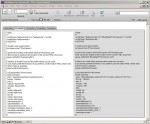Over the past decade I’ve gone through my fair share of panorama formats for online delivery; QTVR, java, Flash and HTML5 to mention a few. Dealing with format changes, or switching viewers can pose a number of problems which require a lot of work to resolve so before I begin yet again it’s time for a more sustainable approach.
“So what about PanoPress{{1}}?” I hear you ask. Well yes, it’s a pretty good plugin for WordPress but for me there are still two possible issues that have absolutely no bearing on the quality of the plugin:
- Whilst the short code is simple any customisations on a per panorama basis have to be typed in each time, and changing your mind at a later date requires editing the post again.
- It’s a server-specific solution. If I went mad and wanted to migrate to an a CMS then there would be complications, and I have little enough hair left as it is
I’ve used Filemaker databases before to manage web viewer options and output the necessary code for online delivery{{2}} but these were for static HTML pages. For WordPress or other systems there are a few extra challenges. Online editors like to “clean” any raw code that gets entered which can be really frustrating. To get around this you need a mechanism to insert content without getting processed by the editor but luckily this is pretty standard thing to do.
 Taking the code generation out of the delivery system makes it easy to deliver the same content via different methods. e.g. an include in a WordPress post and a static index page for the folder containing the images. It also lets you use a data management tool to ..well… manage data.
Taking the code generation out of the delivery system makes it easy to deliver the same content via different methods. e.g. an include in a WordPress post and a static index page for the folder containing the images. It also lets you use a data management tool to ..well… manage data.
 About the only other thing I’m doing differently this time is using keyword substitution to insert parameters into a template. This makes designing the template a lot easier than redefining a calculation for the entire code snippet,… and even easier to set up multiple templates. Upgrading or changing viewers should be as simple as creating a new template, exporting the include files and uploading them along with any images/files.
About the only other thing I’m doing differently this time is using keyword substitution to insert parameters into a template. This makes designing the template a lot easier than redefining a calculation for the entire code snippet,… and even easier to set up multiple templates. Upgrading or changing viewers should be as simple as creating a new template, exporting the include files and uploading them along with any images/files.
In my last two posts I’ve used the embed code from 360 Cities{{3}} and the PanoPress plugin{{4}}, but since I haven’t purchased the license for the HTML5 version of KRPano I’m using PTGui’s viewer{{5}} for my first template.
[[1]]http://www.panopress.org/[[1]][[2]]Virtual tour of Melbourne University using PTViewer (java) http://archive.bigben.id.au/mu_tour/[[2]][[3]]https://bigben.id.au/photography/exhibition-building-and-melbourne-museum-panorama[[3]][[4]]https://bigben.id.au/photography/panoramas/baldwin-spencer-building-the-university-of-melbourne[[4]][[5]]http://www.ptgui.com/[[5]]
[ssc][include file="/files/panoramas/arts_centre-20110714-1.php"] [ssc]
[include file=”/files/panoramas/arts_centre-20110714-1.php”]
It’s also quite likely that I’ll incorporate the Zoomify viewers in this as managing the different viewers is also annoying, not to mention getting TinyMCE to play nice… and of course if I’m going to do that then Open Layers is an obvious alternative, especially since it can use the same tile sets.
So it’s not really just for WordPress, nor is it just for panoramas. How useful it will be remains to be seen but I like it already 😉

hey, where on the server is the folder «files»? i got probmles to set the link of the PTGuiviewer.swf. the js-player works…
regards
tobi
Directory listing of the files folder is blocked. I wouldn’t link to any viewers in there because I am likely to change my mind at random and swap viewers around which will break any links.